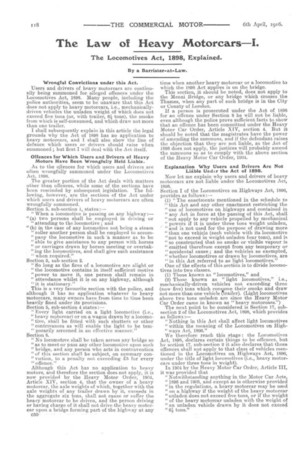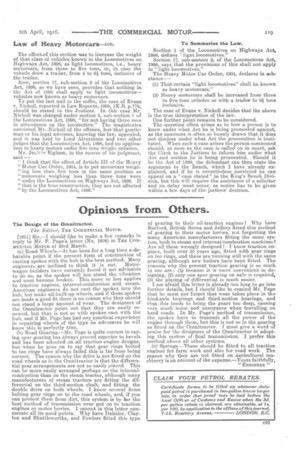The Law of Heavy Motorcars I.
Page 18

Page 19

If you've noticed an error in this article please click here to report it so we can fix it.
The Locomotives Act, 1898, Explained.
By a Barrister-at-Law.
Wrongful Convictions under this Act.
Users and drivers of heavy motorcars are continually being summoned for. alleged offences under the Locomotives Act, 1898. Many people, including the police authorities, seem to be unaware that this Act does not apply to heavy motorcars, i.e., mechanicallydriven vehicles the unladen weight of which does not exceed five tons (or, with trailer, 6 tons), the smoke from which is self-consumed, and which draw not more than one trailer.
I shall subsequently explain in this article the legal grounds why the Act of 1898 has no application to heavy motorcars, and I shall also show the line of defence which users or drivers should raise when summoned; but first I will deal with the Act itself.
Offences for Which Users and Drivers of Heavy Motors Have Been Wrongfully Held Liable.
As to the offences for which users and drivers are often wrongfully summoned under the Locomotives Act, 1898.
The greater portion of the Act deals with matters other than offences, while some of the sections have been rescinded by subsequent legislation. The following, however, are the sections of the Act under which users and drivers of heavy motorcars are often wrongfully summoned.
Section 5, sub-section 1, states:— "When a locomotive is passing on any highway:— " (a) two persons shall beemployed in driving or " attending to the. locomotive ; and
"(b) in the case of any locomotive not being a. steam " roller another person shall be employed to aceom" pany the locomotive in such 'a manner as to be "able to give assistance to any person with horses " or carriages drawn by horses meeting or overtak"big the locomotives, and shall give such assistance "when required."
Section 5, sub-section 2.
" So long as the fires of a locomotive are alight or "the locomotive contains in itself sufficient motive "power to move it, one person shall remain in "attendance whilst it. is on any highway, although "it is stationary."
This is a very favourite section with the police, and although it has no application whatever to heavy motorcars, many owners have from time to time been heavily fined under its provisions.
Section 5, sub-section 4 states:— " Every light carried on a light locomotive (i.e., .
"heavy motorcar) or on a wagon drawn by a locorno" tive, shall be fitted with such abutters or other "contrivances as will enable the light to be tem" porarily screened in an effective manner."
• Section 8.
• "No locomotive shall be taken across any bridge so "as to meet4sr pass any other locomotive upon such "bride, and any person who acts in contravention " of this section shall be subject, on summary con" vietion, to a penalty not exceeding £5 for every "offence."
Although this Act has no application to heavy motors, and therefore the section does not apply, it is now provided by the Heavy Motor Order, 1904, Article XIV, section 4, that the owner of a heavy motorcar, the axle weights of which, together with the axle weights of any trailer drawn by it, exceeds in the aggregate six tons, shall not cause or suffer the heavy motorcar to be driven, and the person driving or having charge of it shall not drive the heavy motorcar upon a bridge forming part of the highway at any c50.
time when another heavy motorcar or a locomotive to which the 1898 Act applies is on the bridge.
This section, it should be noted, does not apply to the Menai Bridge, or any bridge which crosses the Thames, when any part of such bridge is in the City or County of London.
If a person is prosecuted under the Act of 1898 for an offence under Section 8 he will not be liable, even although the police prove sufficient facts to show that an offence has been committed under the Heavy Motor Car Order, Article XIV, section 4. But it should be noted that the magistrates have the power of amending the summons, and if the defendant raises the objection that they are not liable, as the Act of 1898 does not apply, the justices will probably amend the summons so as to comply with the above section of the Heavy Motor Car Order, 1904.
Explanation Why Users and Drivers Are Not Liable UndEr the Act of 1898.
Now let me explain why users and drivers of heavy motorcars are not liable under the Locomotives Act, 1898.
Section I of the Locomotives on Highways Act, 1896, provides as follows Is-
(1) " The enactments mentioned in the schedule to "this Act and any other enactment restricting the "use of locomotives on highways and contained in "any Act in force at the passing of this Act, shall "not apply to any vehicle propelled by mechanical "powers if it is under three tons weight unladen, " and is not used for the purpose of drawing more "than one vehicle (such vehicle with its locomotive "not to exceed in weight unladen four tons), and is "so constructed that no smoke or visible vapour is "emitted therefrom except from any temporary or "accidental cause ; and the vehicles so exempted, "whether locomotives or drawn by locomotives, are "in this Act referred to as light locomotives."
One of the effects of this section is to divide locomotives into two classes.
(1) Those known as "locomotives," and (2) Those known as "light locomotives," i.e., mechanically-driven vehicles not exceeding three (now five) tons which consume their smoke and draw not more than one vehicle traiIer). (Light locomotives above two tons unladen are since the Heavy Motor Car Order came in known as "heavy motorcars.") The next point to be considered is Section 17, subsection 2 of the Locomotives Act, 1898, which provides as follows :— " Nothing in this Act shall affect light locomotives "within the ineaning of the Locomotives on High" ways Act, 1896." We therefore reach this stage : the Locomotives Act, 1898, declares certain things to be offences, but by section 17, sub-section 2 it also declares that those offences shall not apply to that class of vehicles mentioned in the Locomotives on, Highways. Act, 1896, under the title of light locomotives (i.e., heavy motorcars under three tons in weight).
In 1904 by the Heavy Motor Car Order, Article III, it was provided that
"Notwithstanding anything in the Motor Car Acts, "1896 and 1903, and except as is otherwise provided "in the regulations, a heavy motorcar may be used "on a. highway if the weight of the heavy motorcar "unladen does not exceed five tons, or if the weight "of the heavy motorcar unladen with the weight of "an unladen vehicle drawn by it does not exceed "61 tons." The effectof this section was to increase the weight of that class of vehicles known in the Locomotives on highways Act, 1896, as light locomotives, i.e., heavy i
motorcars, from three to five tons, or, n case the vehicle drew a trailer, from 4 to si tons, inclusive of the trailer.
Now, section 17, sub-section 2 of the Locomotives Act, 1898, as we have seen, provides that nothing in the Act of 1898 shall apply to light locomotives— vehicles now known as heavy motorcars. To put the last nail in the coffin, the case of Evans v. Nicholl, reported in Law Reports, 1909, 11C.B. p.778, should be stated to the Justices. In this case Mr. Nicholl was charged under section 5, sub-section 1 of the Locomotives Act, 1898, "for not having three men in attendance on the locomotive." The magistrates convicted Mr. Nicholl of the offence, but that gentleman or his legal advisers, knowing the law, appealed, and it was held by Lord Alverstone and two other judges that the Locomotives Act, 1898, had no application to heavy motors under five tons weight unladen. Mr. Justiee Bigham, in the course of his judgment, said:— " I think that the effect of Article III of the Heavy "Motor Car Order, 1904, is to put motorcars weigh" ing less than five tons in the same position as "motorcars weighing less than three tons were "under the Locomotives on Highways Act, 1896. If "thatis the true construction, they are not affected "by the Locomotives Act, 1898." To Summarize the Law.
Section 1 of the Locomotives on Highways Act, 1896, defines light locomotives."
Section 17, sub-section 2, of the Locomotives -Act, 1898, says that the provisions of this shall not apply to "light locomotives." The Heavy Motor Car Order, 1901, declares in substance :— (1) That certain "light locomotives" shall be known as heavy motorcars."
(2) Heavy motorcars shall be increased from three to five tons unladen or with a trailet to 6i tons . inclusive.
The case of Evans v. Nicholl decides that the above is the true interpretation of the law.
One further point remains to be considered.
The question often. arises as to how a person is to know under what Act he is being proceeded against, as the summons is often so loosely drawn that it does not disclose under what Act the prosecution is instituted. When such a ease arises the person summoned should, as soon as the case is called on in court, ask the Clerk to the Justices to inform him under what Act and section he is being prosecuted. Should it be the Act of 1898, the defendant can then state the argument to the Bench, which I have already explained, and if he is nevertheless convicted he can appeal on a "case stated" to the King's Bench Division, but this will require the assistance of a solicitor and no delay must occur, as notice has to be given within a few days of the justices' decision.






















